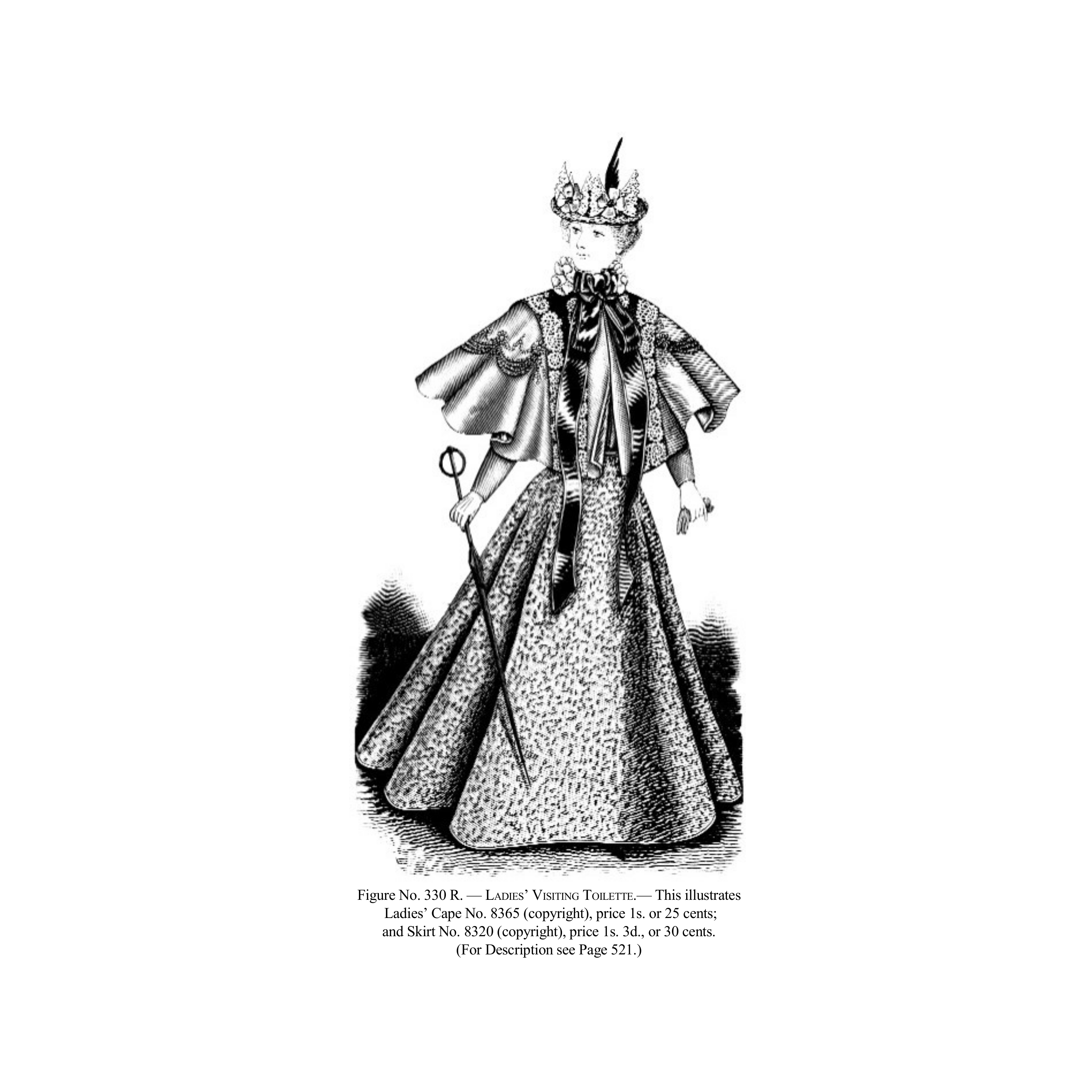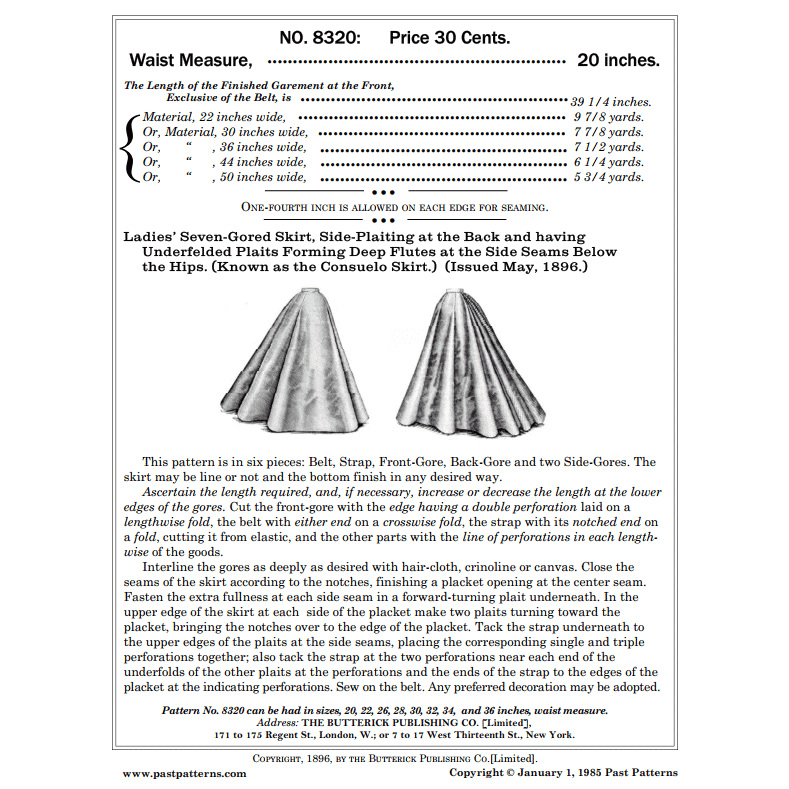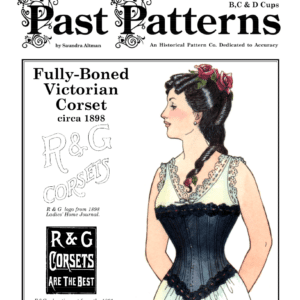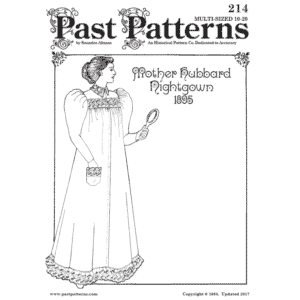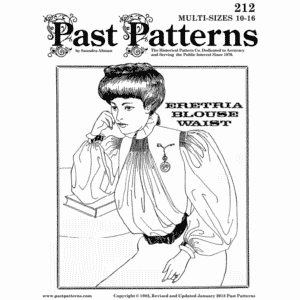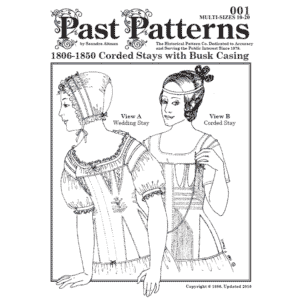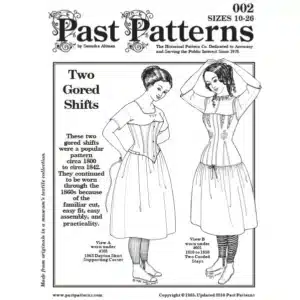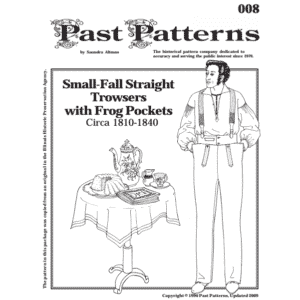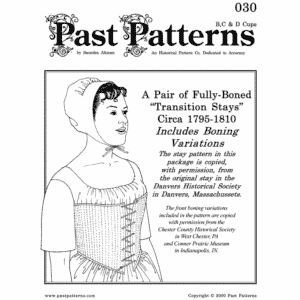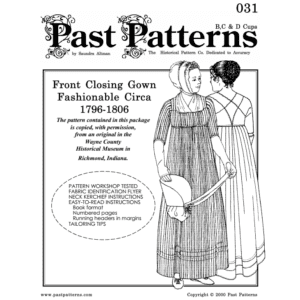All of our patterns tell a story.
Why Choose This Pattern?
This Mid 1890s Seven Gored Skirt pattern was originally published by The Butterick Pattern Company.
★ ★ ★ ★ ★ ★ ★ ★
From Delineator, May 1896, page 525,
“The skirt has novelty and grace to commend it. It is known as the Consuelo skirt and includes seven gores. Extra widths allowed below the Hips at the side edges of all the gores are laid in forward-turns plaits underneath, producing deep rolling folds that are held well in position by a strap tacked across the tops of the plaits. At the front of the skirt shows the fashionable broad flare, and at the back the fulness is arranged at the top in four backward-turning plaits. The skirt measures about six yards round at the bottom in the medium Sizes. The placket is finished above the center seam and the skirt is completed with a belt.
The tendency toward the adoption of classically straight lines is noticeable in the newest skirts, and the fulness is disposed with charming grace.”
Consuelo Vanderbilt (1877-1964) was a member of the wealthy Vanderbilt family. Her marriage to Charles Spencer-Churchill, the 9th Duke of Marlborough, made her a prominent figure in both American and British high society. Her elegant style and high social standing made her a fashion icon, leading to the naming of certain fashion trends, such as the Consuelo skirt, after her.
The Consuelo skirt was a fashion trend of the 1890s. This skirt style typically reflected the luxurious and elaborate fashion sensibilities of the late Victorian era.
One of the key characteristics of the Consuelo include a distinctive silhouette, often featuring a tight fit around the Waist and Hips, flaring out towards the hem. This created an elegant and graceful shape that emphaSized the hourglass figure. The skirts were generally floor-length and sometimes had a slight train, adding to their formal and sophisticated appearance. To achieve the desired shape, Consuelo skirts often included pleats or gores, which allowed the fabric to spread out more fully at the bottom.
These skirts were, fittingly as they were derived from the Vanderbilts, made from rich fabrics such as silk, satin, and velvet. They often featured intricate decorations, including lace, embroidery, and beading, reflecting the opulence of the Gilded Age.
★ ★ ★ ★ ★ ★ ★ ★
The Skirt pattern was designed for the Size and shape of an mid 1890s woman with 20” Waist. This is the only Size provided with the pattern.
For resizing information, see https://pastpatterns.com/resizing-vintage-patterns/
Pattern 8320 has six pattern pieces.
★ ★ ★ ★ ★ ★ ★ ★
Materials
7 1/2 Yds of 36" wide fabric
Suggestions
For a period-accurate garment, Saundra Altman, our founder, suggested using , "silk or woolen fabrics that were colored warm-vivid, garid and/or very startling. The popular finish for the bottom of skirts was a deep facing of haircloth and a velveteen binding."
★ ★ ★ ★ ★ ★ ★ ★
The package has a copy of the original Butterick Publishing Company artwork and written directions on the front cover. THESE ARE THE ONLY INSTRUCTIONS INCLUDED WITH THIS PATTERN SET. There are historical notes on the paper pattern industry on the back cover. Inside the booklet is a copy of the original advertising for the 8320 skirt from the issue of Delineator referenced above. The patterns are computer-drawn, emulating the originals, and printed on 36" wide paper.
★ ★ ★ ★ ★ ★ ★ ★
Our patterns are printed on 20 lb. white paper and packaged in a reusable plastic. We always attempt to offer the most reasonable shipping rates for domestic and international orders. Multi item purchases are automatically adjusted for combined shipping.
★ ★ ★ ★ ★ ★ ★ ★
Past Patterns 2024. All rights reserved.
Disclaimer: This pattern is a historically accurate reproduction of an original Butterick pattern first published in the late 19th or early 20th century. The original design is now in the public domain. Past Patterns is not affiliated with, endorsed by, or licensed by Butterick, which is currently a trademark of CSS Industries and/or its parent company. All references to “Butterick” are made solely for historical and descriptive purposes to acknowledge the source and era of the original publication.
Additional information
| Weight | 10 oz |
|---|---|
| Dimensions | 13 × 10 × 2 in |
Sizing Information
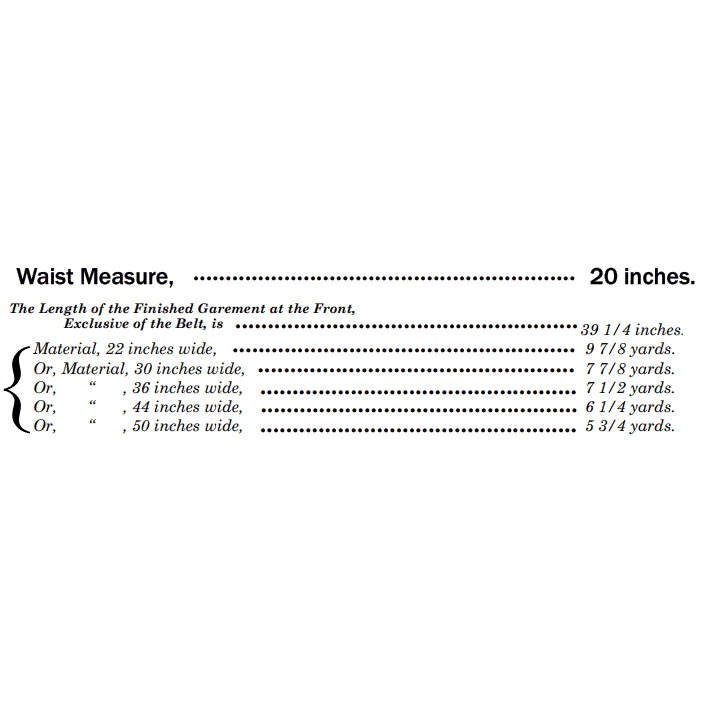
(Metric size sheet opens as a PDF in a new browser tab)
Preferred Vendors
Past Patterns works with vendors from all over the world to help us replicate the amazing articles of clothing. Now you can too!
Visit our preferred vendors page to order directly from some of our top recommended suppliers.
FAQ's
(Frequently asked questions)
Why are both Trowsers and Trousers listed on site?
Over the last 200 years, much like the human body, our style of language has changed. For vintage patterns, we attempt to use the language of the day where possible.
Can you grade (edit) a Vintage Revival pattern for my size?
please contact us with the specific pattern number and the specifications you require. We have staff available for this for an additional fee.
What sizes do Past Patterns patterns come in?
Our patterns, with some exceptions, are manufactured in sizes 8 through 26 for women and sizes 34 through 54 for men. Most patterns are multi-sized. For a complete listing of measurements in inches see the size chart.
Do you have vintage patterns (manufactured prior to 1950) that you want to sell?
we are always on the lookout for original, American designed, vintage patterns especially for categories outside of current items. We are interested if you have 1 pattern or 1000 patterns. Give us a call to discuss.
Why is my pattern size different from my off the rack dress size?
We use the U. S. Board of Standard Measurements to size our patterns. The ready made clothing manufacturers have their own set of sizes developed from their own statistics. For a complete listing of measurements in inches see the size chart.
How are the patterns packaged?
We package our patterns in two forms: Bond Paper and Tissue. Except for the Tissue patterns, each is slipped into a reusable plastic sleeve. Many contain documentation in the form of Historical Notes or the printer ie., Butterick. Because the patterns are printed in house to order, they can take from three to seven days. Tissue patterns, which are printed out of house, are available to ship immediately.
What does a Corset Kit contain in addition to the Corset pattern?
In addition to the pattern, the kits contain everything you need to make the corset except the thread. The kits contain, according to their type, fabric and lining, stays, clasp or busk board, back lacing, tape for finishing the edges, trim lace, ribbon, leather, tin stock, waist tape, punch and setter, eyelets, marking pencils, cording, reed and a loop turner.
Need a pattern in your language?
we can translate our instructions into just about any language
Have an old and incomplete Past Patterns item. What can I do?
The answer depends on if the pattern is still in production or not. If it is, please mail us the old pattern and we will ship you a copy of the latest pattern for a minimal fee along with normal shipping charges. If the item is no longer in production, we would need to know exactly what you have to determine the best course of action to help you.
What is the difference between a Past Patterns original pattern and a Vintage Revival pattern?
The Past Patterns originals were designed in house and based upon the research, disassembly and time of Saundra Ros Altman. These designs come from finds all over the United States reaching from San Diego, California to the Smithsonian Museum in Washington, DC. She created the initial patterns, the sizing charts and the instruction content. Many of the these patterns are multi-sized or are available in various sizes. For the most part, these designs are done taking into account the modern human body's shape, height and weight. The Vintage Revival patterns are traces or copies of an old, mass produced pattern; the first mass produced patterns came out in the 1850s. For the most part, you get exactly what came in the original package; in some cases, Saundra has appended historical notes to the instructions. The Vintage Revivals patterns, being copies of the originals, generally only come in one size and are based upon the size and shape of the human body from the era the pattern came from.
What software do you use to create patterns?
We utilize PW Studio for our designs. Isabelle Lott, a contributor over the years to Past Patterns, is the owner of the company and will be happy to answer an software related questions you have. Her software is available for licensing.
What measurements do I need to know to order a Corset Kit?
The bust and back length. The back length is measured from the prominent bone at the base of the neck to the natural waistline.
Where can I see the appropriate clothing fabrics for the 18th and 19th centuries?
You can see 1740 through 1940 fabrics in a book titled "Textile Designs" by Susan Meller and Joost Elffers. The subtitle states, "Two Hundred Years of European and American Patterns for Printed Fabric by Motif, Style, Color, Layout and Period and 1,823 Illustration in Color." What they don't say is that 90% of the swatches pictured are life size. The ISBN is 0-8109-3853-7. A second book is Wearable Prints, 1740-1860, History, Materials, and Mechanics by Susan W. Greene. The ISBN is 978-1-60635-124-6. Great books! Order it from your local library that has interlibrary loan capability if you cannot afford the price. There are now many sources for appropriate fabric through the Internet.
Where can I find antique patterns to purchase?
On the Internet try: "Patterns from the Past."
Need a pattern tomorrow?
we do offer expedited domestic shipping for extra fees. We can also expeditie international shipments but delivery dates overseas cannot be promised.
Becoming a Wholesalers of our patterns
We offer Wholesalers significant discounts that will allow both your and our businesses to flourish.
Why don't we sell PDFs of our patterns - First due to piracy. We have spent over 40 years creating and tracing these patterns along with researching them. We print and ship all of our patterns ourselves. If we started sending out PDFs, in no time, copies of our Intellectual Property would be all over the internet and we would be out of business. Second, some of our patterns are constantly being updated. We want our clients to get the BEST POSSIBLE version of our products.

